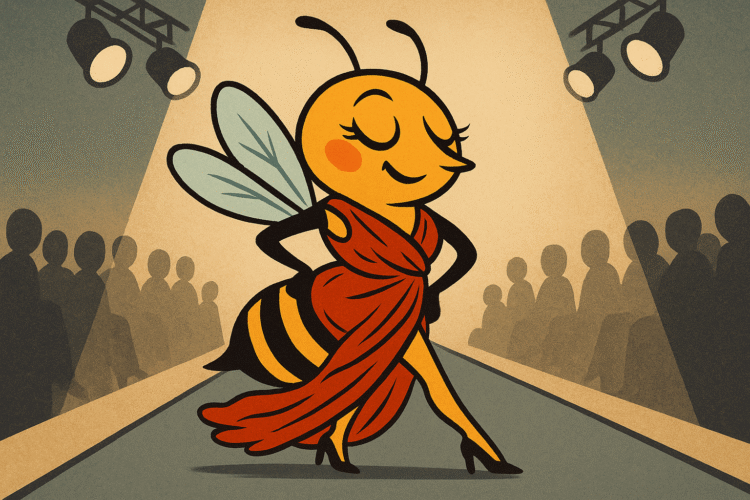
There are few constants in American life. Gas will always creep back up in price the day before a holiday weekend. The McRib will haunt us like a greasy poltergeist every couple of years. And for me, Project Runway will forever be the great cathedral where art, camp, ego, and polyester chiffon collide in holy matrimony. I have seen every season. Every rebrand. Every Tim Gunn make it work. Every Heidi Klum auf Wiedersehen. And not once did I consider changing the channel.
Because this show is not just about fashion. It’s about survival, evolution, and watching otherwise normal people have public meltdowns over muslin. It is, in short, America.
The First Commandment: Make It Work
The beauty of Project Runway has never been the clothes. Let’s be real—half the winning looks wouldn’t survive a Forever 21 clearance rack. No, the beauty lies in the pressure cooker. You give a designer twelve hours, two yards of discount satin, and a model who looks vaguely pissed, and you will see the human psyche unravel faster than a poorly sewn hem.
Tim Gunn, the patron saint of poise, would glide in like a benevolent specter of judgment, offering the most devastatingly polite critiques ever televised. “It’s…a lot of look,” he’d murmur, which in designer translation meant: please don’t embarrass me in front of Nina Garcia.
And God help you if Nina Garcia furrowed her brow. That was the sound of your career being folded neatly and placed in the clearance bin.
High Fashion, Low Drama (Except It’s Always High Drama)
The show’s genius is that it pretends to be about clothing while actually being a masterclass in psychological warfare. Contestants regularly dissolve into tears over bobbin tension. Adults threaten to quit reality television over organza. And somehow, Michael Kors would appear once a season to call something “a disco pumpkin,” and it was the only critique that mattered.
Every season had its archetypes:
- The Visionary who wanted to reinvent the silhouette of the human body using only burlap.
- The Hot Mess who forgot how zippers worked.
- The Sweetheart who cried when other contestants cried.
- The Villain who insisted everyone else was sewing “costume” while their own look resembled a Spirit Halloween clearance sale.
And we, the loyal audience, ate it up like it was a front-row seat at Fashion Week.
Fashion as Gladiator Sport
Do not underestimate the drama of watching someone sprint through Mood Fabrics like it’s the Colosseum. Swatches fly. Bolts collapse. There is always that one contestant who chooses an ill-fated brocade because “it spoke to me.” (It also screamed at the judges, loudly, in polyester.)
Then comes the runway, a ritual sacrifice before the tribunal of Michael, Nina, and whoever Bravo or Lifetime managed to bribe that week. Heidi, flawless and feral, would cut designers down with a single Germanic syllable. Guest judges would range from actual icons (Diane von Fürstenberg) to random actors clearly there to promote a midseason sitcom.
But that’s the brilliance: you could be the next Christian Siriano or you could flame out spectacularly. Both were equally entertaining.
What I Learned from Two Decades of Runway
I learned that no matter how bad my day was, at least I didn’t have to construct a ballgown from automotive parts in eight hours. I learned that confidence is ninety percent of fashion—if you strut hard enough, even a duct-tape romper looks like couture.
I learned that America loves a redemption arc. (Raise your hand if you sobbed when the underdog finally nailed tailoring week.)
Most importantly, I learned that queerness—loud, unapologetic, sequined queerness—has always been stitched into the DNA of the show. From the contestants to the judges to the camp of it all, Project Runway has always been more than entertainment. It’s been a safe runway for weirdness, brilliance, and every shade of gay drama imaginable.
The Eternal Return of the Catwalk
They can reboot it. They can move it between networks like a foster child. They can shuffle judges until only Nina Garcia remains, sipping her martini of silent judgment. And still, I will watch.
Because when the lights go up, the music kicks in, and some poor designer mutters “please don’t fall apart” as their garment walks the runway, I remember why I fell in love in the first place.
Project Runway is not just a TV show. It is proof that art, absurdity, and human breakdowns can coexist in a single stitch. It’s couture chaos, democratized for the masses. It’s camp in its purest form. And like a Tim Gunn pep talk, it never fails to remind me: even in the most disastrous fabric of life, we can always—always—make it work.